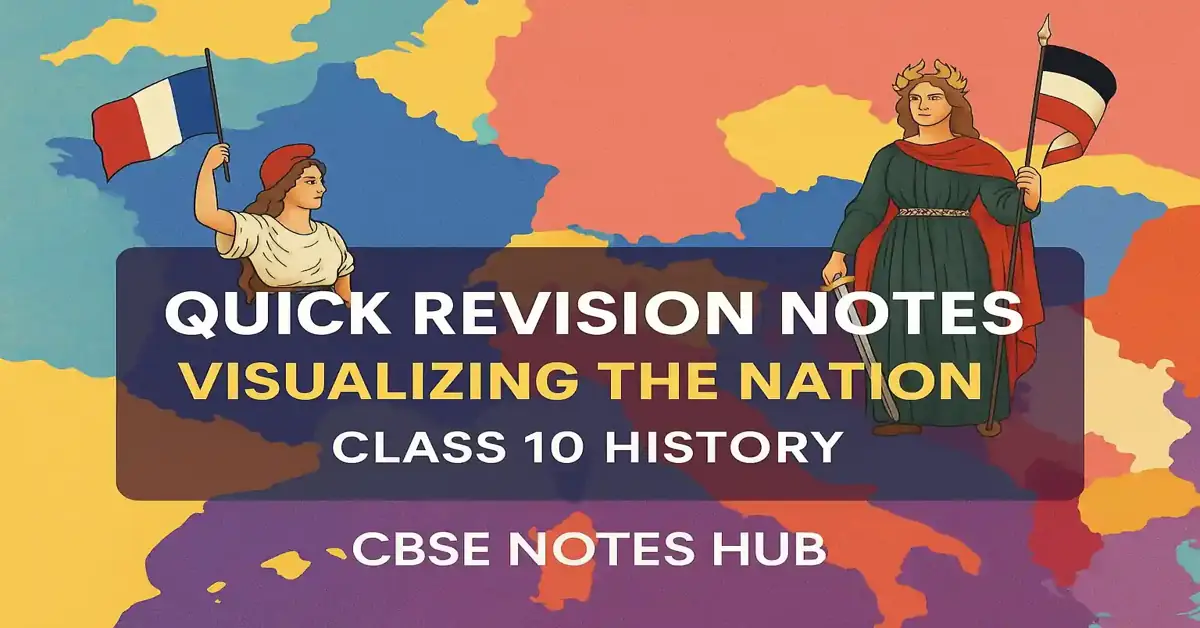Visualising the Nation Class 10 History Chapter 1 Notes help students understand how artists gave nations a face and personality during the rise of nationalism in Europe. This part of the chapter introduces powerful allegories like Germania and Marianne, used to represent Germany and France. You’ll also explore how symbols like swords, olive branches, and broken chains expressed national values. Towards the end, we dive into the Balkan issue and how nationalism—mixed with imperialism—became a major cause of tension before the First World War. Don’t forget to check out Part 5 for detailed notes on the unification of Germany, Italy, and Britain:
Easy and Quick Notes
Chapter – 1: Rise of Nationalism in Europe
Part – 6
Visualising the Nation
- Artists in the 18th and 19th centuries portrayed the Nations as female figures.
- Allegory – When an abstract idea is expressed through a person or thing.
- Germania represented Germany.
- Marianne represented the Republic of France.
Meanings of the Symbols
- Broken Chains – Freedom
- Breastplate with Eagle – Strength of German Empire
- Crown of Oak Leaves – Heroism
- Sword – Preparedness to fight
- Olive Branch around Sword – Desire for peace
- Black, Red & Gold Tricolour – Flag of 1848 liberals (banned by Dukes)
- Rays of Rising Sun – Start of a new era
Nationalism and Imperialism – The Balkan Issue
- By the last quarter of the nineteenth century, nationalism lost its idealistic, liberal, democratic sentiments.
- Nationalist groups became intolerant of each other.
- They wanted to take over the territories of other nations.
- After 1871, Balkan became the most serious source of nationalist tension.
- Balkans was a region of ethnic and geographical variations.
- It was inhabited by Slavs and was under the control of the Ottoman Empire.
- Ideas of nationalism swept over the entire Balkan region.
- With the spread of romanticism and disintegration of the Ottoman Empire, Slavic nationalists struggled to define their identity.
- Each Balkan state developed jealousy and tried to gain more territory at the expense of the others.
- European powers further complicated the situation.
- Each power – Russia, Germany, England, Austria-Hungary – was keen on countering the hold of other powers over the Balkans and extending its own control over the area.
Conclusion
- Nationalism aligned with imperialism led to a series of conflicts in the region and finally dragged Europe into the First World War in 1914.
If you haven’t yet explored how nationalism began spreading across Europe, make sure to check out Part 3, where we explained the rise of cultural and political nationalism in CBSE Class 10 History. It sets the foundation for understanding how visual symbols and identity-building became central to national movements.
To help you revise better and clear common doubts, here are some frequently asked questions based on Visualising the Nation Class 10 History Chapter 1 Notes.
Q. Name the female allegory of the German nation?
A. Germania is the female allegory that represents the German nation.
Q. Name the female allegory of France?
A. Marianne is the female allegory that represents the French Republic.
Q. What type of leaves does the allegory Germania wear as a crown symbolizing heroism?
A. Germania wears a crown made of oak leaves, which symbolize heroism.
Q. Who were Slavs?
A. Slavs were an ethnic group living in the Balkan region, many of whom were under Ottoman rule during the rise of nationalism.
Understanding how nations were visualised helps us see how art, symbols, and emotions were used to build powerful identities. From Germania to the Balkan conflicts, this part of history shows us how imagination shaped reality. Want more such exam-ready notes? Explore all our Class 10 History resources on the CBSE Notes Hub homepage.


